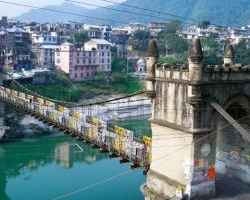Chamba is the only state in northern India to preserve a well-documented history from circa 500 A.D. Its high mountain ranges have given it a sheltered position and helped in preserving its centuries old relics and numerous inscriptions. The temples erected by rajas of Chamba more than a thousand years age continue to be under worship and the land grant-deeds executed on copper plates by them continue to be valid under the law.
Regarding the early history of this region it is believed that this area was at time inhabited by certain Kolian tribes,which were later, subjugated by the Khasas. The Khasas too after a time came under the sway of Audumbaras (2nd centaury B.C.). The Audmabaras had republican form of government and worshiped Shiva as their principal deity. From the Gupta period (4th Centaury A.D.) the Chamba region was under the control of Thakurs and Ranas who considered themselves superior to the low tribes of Kolis and Khasas. With the rise of Gurjara Pratiharas ((7th Centaury A.D.) the Rajput Dynasties came to power.
In circa 500 A.D., a legendry hero called Maru migrated to north-west from Kalpagrama (a mythical place from where majority of the Rajput dynasties claim their descent) and founded Brahamputra (Bharmour) in the valley of the Budhal river, seventy five kilometer to the east of present Chamba town. His successors continued to rule over the country from that capital city for over three hundred years until Sahilla Varman shifted his capital from Brahamputra to the more centrally located plateau in the lower Ravi valley. He named the town after his beloved daughter Champa. His rani voluntarily offered herself as a scarifies to bring water for the town’s people through a running channel which takes origin at a place called Bhalota. The layout of the plan of Chamba seems to be in conformity with the ancient texts. From then on the rajas of Chamba continued to rule from here in an uninterrupted and direct line of descent.
The Muslims never invaded Chamba, though it had its occasional fights with the neighboring states in the hills having similar cultural background. Thus,the damage to Chamba from these invasions was seldom serious and never beyond the possibility of repair. Even the powerful Mughals were
kept at bay on account of difficulties involved in communications and long distances. Akbar tried to extend a loose control over the hill states including Chamba and attached fertile tracts of these states to the imperial territory south of Dhauladhar. Aurangzeb once issued orders to the Raja of Chamba Chatter Singh (1664-1694AD) to pull down the beautiful temples of Chamba. But instead the raja in clear defiance to the Mughal ruler placed glided pinnacles on the temples. He was ordered to come down to Delhi to face the imperial wrath. But Aurangzeb himself had to leave for the Deccan from where he could not disentangle till the end of his life. On the whole, the northern India experienced comparatively peaceful condition during the Mughal regime Raja Prithvi Singh (1641-1664 AD), a handsome and a gallant knight was favourite of Shahjahan and visited the imperial court many times. He introduced the Mughal style of court life including Mughal-Rajput art and architecture in Chamba.
By the last quarter of 18th centaury the Sikhs forced the hill states to pay tribute to them. Maharaja Ranjit Singh systematically deposed the hill prices including the more powerful Kangra ruler Sansar Chand Katoch but spared Chamba in lieu of the services Wazir Nathu (of Chamba) had rendered him on two occasions. In 1809 A.D. the Wazir had made himself useful to the Maharaja by negotiating his agreement with Raja Sansar Chand Katoch, of Kangra. Again in A.D.1817 he had saved Ranjit Singh’s life by offering his horse at a critical moment during formers winter campaign in Kashmir. After Ranjit Singh’s death Chamba became un-protected and was drawn into the vortex of the disintegration of the Sikh Kingdom. The Sikh army invaded the British territory in A.D. 1845 and the troops of Sikh army, which were stationed in Chamba, were with drawn. When Sikh’s were defeated it was decided to merge Chamba in Jammu and Kashmir but on account of the timely intervention of Wazir Bagha (of Chamba) it was taken under the British control and subjected to the annual tribute of 12,000 rupees. The Raja’s who saw something of British hegemony were Sri Singh, Gopal Singh, Sham Singh, Bhuri Singh, Ram Singh and laxman Singh. Their relations with the British political officers seem to be cordial and Chamba witnessed many reforms.
On 15th April 1948 merging three principal states formed A.D. Himachal…. Chamba, Mandi-Suket, Sirmour and all the other state falling in Shimla hills.
Before Raja Sahilla Varman came on the same the Chamba region was divided into bits and pieces of territory called Rahnu occupied by numerous Ranas and petty Chieftains who carried on relentless warfare with each other. Raja Sahilla Verman subjugated the Ranas and unified the territory. Rajas, therefore, for better administration divided Chamba into five zones known as Mandlas. These Mandlas were later reamed as Wizarats. This five fold division of Chamba region continues till today. The Wizarats are now called Tehsils. These are Bharmour, Chamba, Bhattiyat, Churah and Pangi.
--



Comment with Facebook Box